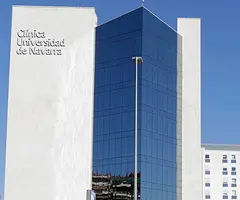Multiple myeloma
"Our goal is to provide a precise diagnosis and early treatment to cure myeloma".
DR. JESÚS SAN MIGUEL
SPECIALIST. HEMATOLOGY AND HEMOTHERAPY DEPARTMENT

Multiple myeloma is a type of cancer that affects plasma cells, a type of white blood cell found in the bone marrow. It is the second most common haematological tumour after lymphomas.
The treatment of this disease has changed significantly in recent years thanks to the development of new therapies, such as the approval of 5 new drugs that have doubled the survival of myeloma patients.
At the Cancer Center Clinica Universidad de Navarra we are a reference centre for the preclinical research of new treatments, in collaboration with different pharmaceutical companies.
We offer personalised treatment and monitoring. The drugs administered and the intensity are individualised according to the characteristics of each patient.

A PERSONALIZED MEDICINE
Second Opinion,
peace of mind
Request a second opinion from our professionals with great experience in the diagnosis and treatment of oncological diseases
In 3 days, without leaving home.
Symptoms of multiple myeloma
The uncontrolled proliferation of these cells can manifest itself in various ways, depending on the type and stage of the disease.
Symptoms according to the type of myeloma
- Monoclonal gammopathy of uncertain significance (MGUS): This is the most common form and is considered "benign". It is characterised by the presence of a monoclonal protein in blood or urine due to a small proliferation of plasma cells, without other alterations. Only 11% of cases progress to multiple myeloma.
- Asymptomatic or quiescent myeloma: In this stage, there is an increased number of tumour cells in the bone marrow and an increased concentration of monoclonal protein in blood and/or urine, but still no symptoms. Progression is uncertain; some cases behave like "benign" MGUS, while others progress to active myeloma and are considered high risk.
- Symptomatic multiple myeloma: In this phase, symptoms such as anaemia, bone lesions, renal failure or increased calcium in the blood appear, together with other alterations detectable in analyses or radiological studies, requiring immediate treatment.
Common symptoms of multiple myeloma
- Anaemia: The proliferation of plasma cells in the bone marrow crowds out normal cells, causing anaemia. Associated symptoms include tiredness, pallor, tachycardia and hot flushes.
- Bone pain: Bone destruction can cause pain of varying intensity and even fractures due to spontaneous or minor trauma.
- Kidney failure: The abnormal monoclonal protein produced by the atypical cells can leak through the kidney, causing kidney damage.
- Hypercalcaemia: Increased calcium in the blood, resulting from bone destruction, can lead to symptoms such as constipation, excessive thirst, dehydration and confusion.
- Recurrent infections: Disruption of normal antibody production can weaken the immune system, increasing susceptibility to infections.
Do you have any of these symptoms?
If you suspect that you have any of the above symptoms,
you should consult a medical specialist for a diagnosis.
Diagnosis of multiple myeloma
We offer personalised medicine through comprehensive genetic and phenotypic diagnosis to optimise treatments.
Flow cytometry: Essential for assessing monoclonal gammopathies, it allows characterisation of plasma cell markers and improves myeloma diagnosis and prognosis. We have developed advanced methods to detect minimal residual disease and monitor treatments more accurately.
Genetic studies: Key to myeloma prognosis. Sequencing and mutation analysis identify unfavourable alterations even in normal tests and guide specific treatments.
Diagnostic imaging: Positron emission tomography (PET): performed with glucose and methionine. Whole-body CT with low radiation doses: allows high-quality images to be obtained with greater sensitivity than conventional radiography. 3 tesla MRI: the most powerful MRI that achieves greater diagnostic accuracy of the images.
Treatment for multiple myeloma
For patients under 70 who meet the criteria, the ideal treatment would be an autologous bone marrow transplant.
Four or five cycles of induction treatment are performed with new drugs (bortezomib, thalidomide, lenalidomide, etc.) and then an autologous transplant is performed.
After this treatment, new drugs can be administered to strengthen and maintain the response to the disease.
If the patient is not a candidate for an autologous bone marrow transplant, the treatment indicated is the administration of alkylating agents: melphalan, prednisone, etc. This was the standard treatment a few years ago, but it is now complemented with these new drugs:
- Monoclonal antibodies such as daratumumab and isatuximab, BCMA bispecific antibodies.
- New immunomodulators: pomalidomide, lenalidomide, etc.
- Next-generation proteasome inhibitors: oprozomib, carfilzomib, etc.
- Other selective inhibitor drugs: venetoclax, selinexor, panobinostat, etc.
We have more than 30 ongoing trials at all stages of the disease and with all the different drugs being evaluated for myeloma, as well as autologous and allogeneic transplantations:
CAR T cells versus BCMA
Monoclonal antibodies:
- Daratumumab
- Isatuximab
- BCMA bispecific antibodies
Next-generation proteasome inhibitors
- Oprozomib
- Carfilzomib
New immunomodulators
- Pomalidomide
- CELMoDs, third-generation immunomodulatory drugs
New alkylating agents
- Melflufen
Checkpoint inhibitors
Other drugs (selective inhibitors)
- Venetoclax
- Selinexor
- Panobinostat
What clinical trials do we have on myeloma and other monoclonal gammopathies?
Advanced Therapies Unit
The Advanced Therapies Unit of the Clínica Universidad de Navarra develops cell therapies against cancer and other diseases of the immune system.
It is implemented by a highly specialised multidisciplinary team of nurses, together with doctors from all the specialties involved.
Where do we treat it?
IN NAVARRA AND MADRID
The Hematology and Hemotherapy Service of the
at the Clínica Universidad de Navarra
The Hematology Service of the Clinic, formed by specialists of recognized national and international prestige, has integrated molecular diagnostic techniques and the use of new personalized treatments in its assistance work, allowing a more precise and fast diagnosis of the hematological diseases.
The joint work of the medical staff and the researcher facilitates the development and application of the new treatments and at the same time the precise evaluation of the result of the treatments.

Why at the Clinica?
- Experts in the development of Cellular Therapy treatments.
- International reference center in lymphomas, multiple myeloma and monoclonal gammopathies.
- Experts in the diagnosis and treatment of hemorrhagic and thrombotic problems.
Our team of experts in multiple myeloma

THE TARGET OF MULTIPLE MYELOMA
Multiple Myeloma Research Group
Our research group at the Cima Universidad de Navarra, made up of internationally renowned researchers, seeks new therapeutic alternatives to treat multiple myeloma.
One of our research lines is focused on identifying resistance biomarkers and potential therapeutic targets for multiple myeloma.




























